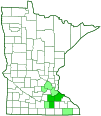Minnesota dwarf trout lily
(Erythronium propullans)
Conservation • Description • Habitat • Ecology • Use • Distribution • Taxonomy
Conservation Status |
|
|||||||
| IUCN Red List | not listed |
|||||||
| NatureServe | N1 - Critically Imperiled S1 - Critically Imperiled |
|||||||
| Federal | Endangered |
|||||||
| Minnesota | Endangered |
|||||||
Description |
||
Minnesota dwarf trout lily is a rare, erect, perennial forb. It is found as colonies of 1 or 2 up to 500 plants. The plant rises from a short, vertical, thickened, underground stem (corm). Almost all of the plants in a colony will flower each year. Most plants are two-leaved and produce flowers. Non-flowering plants have one leaf. The leaves appear to originate at the base, but they actually originate below ground, about halfway up the underground stem. They are arranged in pairs but are not exactly opposite. They are 1½″ to 5″ long, lance-shaped, untoothed, fleshy, green, flat, mottled or spotted with silver, and covered with a whitish, waxy coating. The inflorescence is a solitary flower hanging downward at the end of a stout, nodding stem. The stem is 1½″ to 4¾″ tall, hairless and leafless. The flower is dime-size or smaller and has 4 to 6 tepals, usually 5. The tepals are ⅓″ to ⅔″ long, lance-shaped, and white or pinkish-white. They flare outward, extending nearly to the horizontal, eventually curving backward. The anthers are yellow. The plant reproduces vegetatively from a single creeping stem on fertile plants that roots at the nodes sending up new plants (stolons). Fruits are rarely produced. When they are it may be the result of hybridization with white trout lily. They are small and nodding, not erect. |
||
Height |
||
1½″ to 5″ |
||
Flower Color |
||
White or pinkish-white |
||
Similar Species |
||
White trout lily (Erythronium albidum) is sympatric with Minnesota dwarf trout lily. Where the two species occur together non-blooming plants are indistinguishable. However, less than 1% of the plants in a colony will flower in any given year. Therefore, if a carpet on one-leaved non-flowering plants are seen they may be white trout lily but cannot be Minnesota dwarf trout lily. white trout lily is a larger plant. The leaves are 3″ to 8½″ long. The flowering stem is 4″ to 6″ long. The flower always has 6 tepals. The tepals are 1″ to 2″ long and white or bluish-white with yellow near the base. |
||
Habitat |
||
Moist. Floodplain woods, river terrace, northwest and northeast facing slopes. |
||
Ecology |
||
Flowering |
||
Mid-April to early or mid-May |
||
Spring Ephemeral |
||
Minnesota dwarf trout lily is a true spring ephemeral. All of the parts of the plant that are above ground will have disappeared by the time the forest canopy has developed in June. |
||
Pests and Diseases |
||
|
||
Use |
||
|
||
Distribution |
||||
|
Sources 2, 3, 4, 5, 6, 7, 23, 28, 29, 30. The map at left shows the native range of Minnesota dwarf trout lily in dark green and five records outside the native range in light green. There is a captive (transplanted) population at the Eloise Butler Wildflower Garden in Wirth Park (Hennepin County), and another at the University of Minnesota Landscape Arboretum in Chanhassen (Carver County). The U.S. Fish & Wildlife Service County Distribution of Federally-Listed Threatened, Endangered, Proposed, and Candidate Species lists Dakota and Waseca Counties as counties where the plant “is known or believed to occur." The Biota of North America Program reports an occurrence in Fillmore County. |
|||
| 5/13/2023 | ||||
Nativity |
||||
Native |
||||
Occurrence |
||||
Rare Minnesota dwarf trout lily is endemic to Goodhue and Rice Counties in Minnesota, hence the name. It is also found in Steele County. It occurs only at elevations vof 960 to 1,000 feet above sea level. The major populations are found on the slopes of the Canon and Straight Rivers near Faribault. Smaller populations occur along the Little Cannon River, Zumbro River, North Fork Zumbro River, and Prairie Creek watersheds. Some of the public places this plant can be found are Nerstrand Big Woods State Park; Clinton Falls Dwarf Trout Lily SNA; Cannon River Trout Lily SNA; North Fork Zumbro Woods SNA; Prairie Creek Woods SNA; Eloise Butler Wildflower Garden in Wirth Park, Minneapolis; River Bend Nature Center in Faribault; and the University of Minnesota Landscape Arboretum in Chanhassen. In Nerstrand Big Woods State Park look for it along the boardwalk on the Hidden Falls Trail, where it may be pointed out – and protected – by a park ranger; and along the north-facing slopes of Prairie Creek. Look for it mainly on lower parts of north-facing slopes that rise 40–80 feet above streams or abandoned stream channels. It can occasionally be found on northwest and northeast facing slopes. |
||||
Taxonomy |
|||
| Kingdom | Plantae (Plants) | ||
| Division | Tracheophyta (Vascular Plants) | ||
| Subdivision | Spermatophytina (Seed Plants) | ||
| Class | Liliopsida (Monocots) | ||
Order |
Liliales (lilies, supplejacks, and allies) | ||
Family |
Liliaceae (lilies) | ||
| Subfamily | Lilioideae | ||
| Tribe | Tulipeae | ||
Genus |
Erythronium (fawn lilies) | ||
Some sources, including GRIN, place the genus Erythronium in the tribe Lilieae. Other sources, including iNaturalist, separate Erythronium with the genus Tulipa and six other genera into the tribe Tulipeae. |
|||
Subordinate Taxa |
|||
|
|||
Synonyms |
|||
|
|||
Common Names |
|||
adder’s tongue dwarf trout lily dwarfadder’s tongue fawn lily Minnesota adder’s tongue Minnesota fawnlily Minnesota trout lily |
|||
Glossary
Stolon
An above-ground, creeping stem that grows along the ground and produces roots and sometimes new plants at its nodes. A runner.
Sympatric
Referring to closely related species that have ranges that overlap but which do not interbreed.
Tepal
Refers to both the petals and the sepals of a flower when they are similar in appearance and difficult to tell apart. Tepals are common in lilies and tulips.
Visitor Photos |
|||||
Share your photo of this plant. |
|||||
| This button not working for you? Simply email us at info@MinnesotaSeasons.com. Attach one or more photos and, if you like, a caption. |
|||||
twCarlson |
|||||
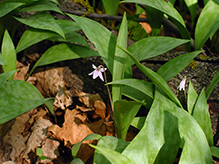 |
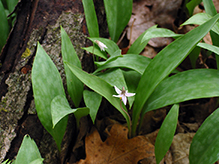 |
||||
MinnesotaSeasons.com Photos |
|||||
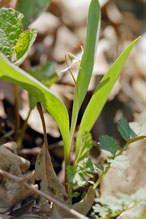 |
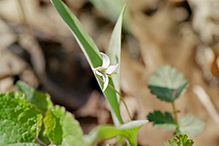 |
||||

Slideshows |
||

Visitor Videos |
|||
Share your video of this plant. |
|||
| This button not working for you? Simply email us at info@MinnesotaSeasons.com. Attach a video, a YouTube link, or a cloud storage link. |
|||
Other Videos |
|||
| Rare and endangered species blooming! Rosie Schluter |
|||
About
Uploaded on Apr 6, 2010 It only grows in less than 600 acres and appears for fewer than three weeks each year. The Dwarf Trout Lily is an endangered species that only grows in a small area of Minnesota and no where else in the entire world. |
|||

Visitor Sightings |
|||||
Report a sighting of this plant. |
|||||
| This button not working for you? Simply email us at info@MinnesotaSeasons.com. Be sure to include a location. |
|||||
|
|||||
MinnesotaSeasons.com Sightings |
|||||
Eloise Butler Wildflower Garden Nerstrand Big Woods State Park University of Minnesota Landscape Arboretum |
|||||

|
Created: Last Updated: © MinnesotaSeasons.com. All rights reserved. |
